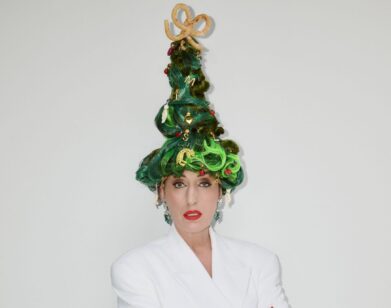At Pitti, Damir Doma is Layered and Light
The influential fashion fair Pitti Uomo and its kid sister Pitti W are in full swing in Florence, offering a chance for the international fashion contingent—and particularly the menswear pros here scouting fashion’s latest moves before heading to the runway marathons in Milan and Paris—to flaunt their own high-summer city style. Dressing for Pitti is based on a “more is more” ethos, but under the hot Tuscan sun (temperatures this week have sizzled into the high 90s, and air-conditioning is far from a guarantee), pared-down and lean have taken the day. Imagine a group of chic lifeguards attending a rescue-skills symposium at a small Mediterranean beach town: cropped and snug white chinos, pastel muscle-man T-shirts, a colorful neck scarf here and there, and striped linen satchels slung over shoulders sums up the prevailing look.
Already an established young name in menswear, the Croatian-born, Bavarian-raised, and Paris-based Damir Doma is Pitti W’s anointed Guest Women’s designer this season. The 32-year-old designer chose the lush gardens of Florence’s Palazzo Corsini to show his Spring/Summer 2014 women’s pre-collection, the first one he’s done with his new Italian production partner Zamasport. “The clothes are graphic, and I felt like I was painting,” said Doma, who previewed a few looks at a working lunch staged in a converted barn on the palazzo’s grounds. Doma also produced a fascinating scrapbook for Fondazione Pitti Discovery, offering a layered sampling of his inspirations.
It begins with one of artist and groundbreaking fashion photographer Erwin Blumenfeld’s fractured 1940s portraits of Jean-Antoine Houdon’s Diana, the huntress. Turn the page, and the slivers of Diana are superimposed with Blumenfeld’s landmark 1937 eyelashes graphic, which is followed by a very young Sigourney Weaver crouching like a panther in a 1966 photograph by Ad Reinhardt. From there, Doma lays on Louise Bourgeois’ gold bronze blob, End of Softness (1967), followed by a sampling from some of his favorite issues of Emporio Armani’s Semestrale magazine (produced in the early 1990s), including a view of an architectural installation on the beach at Rimini. A reclining Sinéad O’Connor in Malibu, shot in 1990 by Herb Ritts, looks like a sculpture come to life before fading behind Mike Meiré’ s gooey white Sexus ceramic and an edgy Robert Mapplethorpe chrysanthemum. Doma’s emotional trek though decades of 20th century art and fashion imagery climaxes with a double page zoom of a model’s tearful, mascara-smeared eye from Helmut Newton’s “Bordighera, Italy” series from 1982 for Italian Vogue. This was a sumptuous prelude to the evening’s show of spliced, sliced, and superimposed pieces that had multiple stories to tell. One filmy, gradated black-and-white striped evening dress was actually a coverup for a burnt orange swimsuit, as though cocktails in the garden of a Florentine palazzo would naturally end up with a late-night dip. Doma’s asymmetrical skirt in a textured purplish blue silk bordered in green wraps around the hips like a beach towel; and one matte, knit white stripe across the chest and arms of a transparent top represents a lighter-than-air feat of technical audacity that a maverick like Blumenfeld, if he were here today, would appreciate.
As Italy searches for its next generation of young designers through competitions—notably Who is on Next, organized by Italian Vogue, which showcases its menswear finalists here at Pitti before highlighting the women’s selection during the Italian couture presentations at Altaroma in mid-July—it’s interesting to consider the independent Damir Doma, a designer who has hopscotched across Europe and is, as he puts it, “In a fashion house where everything is built around the designer.” Stephan Wembacher, CEO and Chairman of Paper Rain, the company has backed Doma since 2007 (when he launched his eponymous brand in Paris after a design stint with Raf Simons), is that rare thing: the right person at the right time with the resources to get a young fashion brand off the ground, prepared to let it take time and willing to put in an increasing amount of effort.
Doma and Wembacher met on a sunny day in front of a bike shop at home in Southern Germany. “Damir and I are from the same region. He was skateboarding with my younger brother, so I always knew about him,” Wembacher said. “I had a completely different business, working for Apple, manufacturing the smart cable for the iPad in Asia.” Wembacher, 39, also had some fashion production experience. When Doma explained that his goal was to build a fashion brand and have a showroom in Paris with a budget he calculated then at 20 thousand Euros, Wembacher thought Doma was a bit fuzzy on the math—but decided to give it a try, anyway.
“There was just eight weeks before Paris men’s fashion week and we had no French skills, contacts, or network,” Wembacher remembers. “But we did know a guy in Brazil who knew somebody in Paris, so we were able to organize a venue and do a little presentation for Spring/Summer 2008. When you work for Apple, it’s always extremely creative at first, but ultimately it becomes very industrialized. This was more freestyle. I was interested in fashion, in Belgian and Japanese brands. When Damir came to see me with the 20 styles he had made in his mother’s basement, I wanted to buy every piece. Over the years, we’ve moved the office three times, changed people. He worked pretty more or less on his own for the first three years, and then we brought in our accountant to box it together again.”
Today, Wembacher estimates that Damir Doma represents about five percent of Paper Rain’s activity, with another five coming from Paris-based rucksack and laptop sleeve maker Côte&Ciel. “Now I’m in Paris every month for about 10 days,” he says. “When you do business in China, you make money within two years. Fashion is much more complex. It’s about people who build their own stories, like Prada. The process takes so much longer. You have to go to Paris, then Italy, there’s fabrics, it’s about people and egos. And it’s expensive. I think I did it because I had already made money, I wanted to have a little bit of fun. Then I liked the challenge, and now I’m a supporter.”







